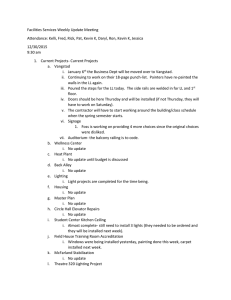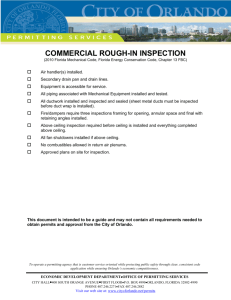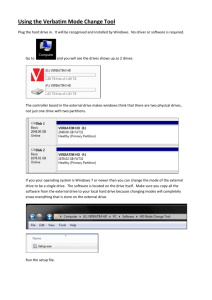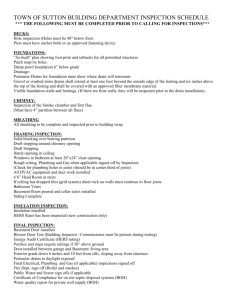2012 IRC Warning Sheet
advertisement
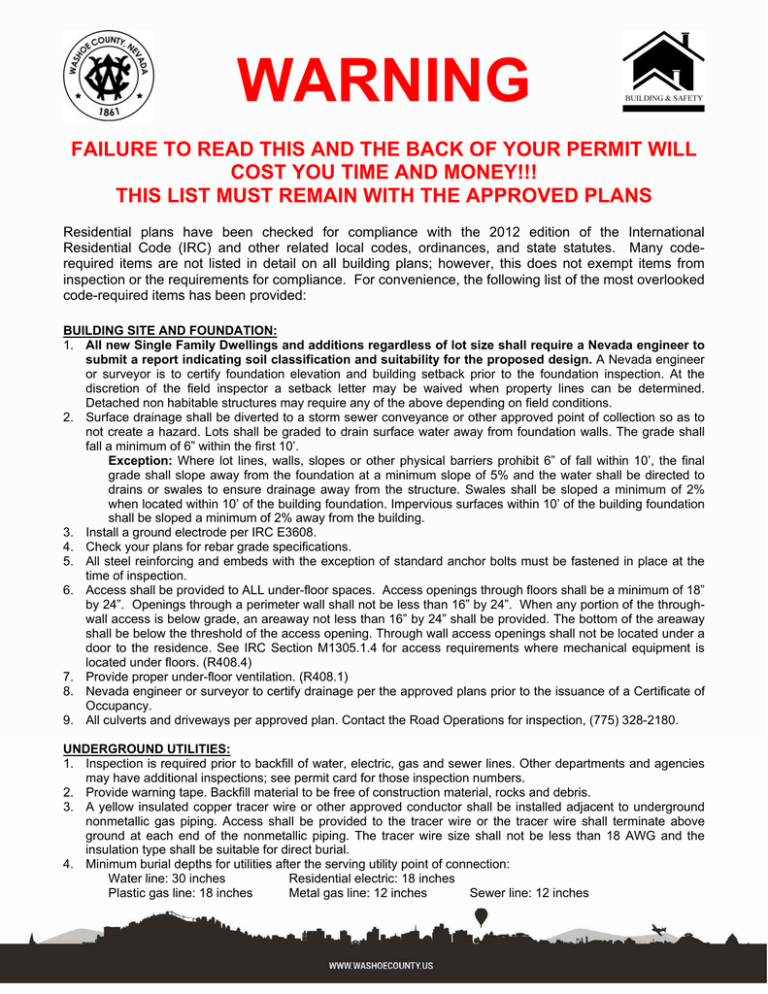
WARNING FAILURE TO READ THIS AND THE BACK OF YOUR PERMIT WILL COST YOU TIME AND MONEY!!! THIS LIST MUST REMAIN WITH THE APPROVED PLANS Residential plans have been checked for compliance with the 2012 edition of the International Residential Code (IRC) and other related local codes, ordinances, and state statutes. Many coderequired items are not listed in detail on all building plans; however, this does not exempt items from inspection or the requirements for compliance. For convenience, the following list of the most overlooked code-required items has been provided: BUILDING SITE AND FOUNDATION: 1. All new Single Family Dwellings and additions regardless of lot size shall require a Nevada engineer to submit a report indicating soil classification and suitability for the proposed design. A Nevada engineer or surveyor is to certify foundation elevation and building setback prior to the foundation inspection. At the discretion of the field inspector a setback letter may be waived when property lines can be determined. Detached non habitable structures may require any of the above depending on field conditions. 2. Surface drainage shall be diverted to a storm sewer conveyance or other approved point of collection so as to not create a hazard. Lots shall be graded to drain surface water away from foundation walls. The grade shall fall a minimum of 6” within the first 10’. Exception: Where lot lines, walls, slopes or other physical barriers prohibit 6” of fall within 10’, the final grade shall slope away from the foundation at a minimum slope of 5% and the water shall be directed to drains or swales to ensure drainage away from the structure. Swales shall be sloped a minimum of 2% when located within 10’ of the building foundation. Impervious surfaces within 10’ of the building foundation shall be sloped a minimum of 2% away from the building. 3. Install a ground electrode per IRC E3608. 4. Check your plans for rebar grade specifications. 5. All steel reinforcing and embeds with the exception of standard anchor bolts must be fastened in place at the time of inspection. 6. Access shall be provided to ALL under-floor spaces. Access openings through floors shall be a minimum of 18” by 24”. Openings through a perimeter wall shall not be less than 16” by 24”. When any portion of the throughwall access is below grade, an areaway not less than 16” by 24” shall be provided. The bottom of the areaway shall be below the threshold of the access opening. Through wall access openings shall not be located under a door to the residence. See IRC Section M1305.1.4 for access requirements where mechanical equipment is located under floors. (R408.4) 7. Provide proper under-floor ventilation. (R408.1) 8. Nevada engineer or surveyor to certify drainage per the approved plans prior to the issuance of a Certificate of Occupancy. 9. All culverts and driveways per approved plan. Contact the Road Operations for inspection, (775) 328-2180. UNDERGROUND UTILITIES: 1. Inspection is required prior to backfill of water, electric, gas and sewer lines. Other departments and agencies may have additional inspections; see permit card for those inspection numbers. 2. Provide warning tape. Backfill material to be free of construction material, rocks and debris. 3. A yellow insulated copper tracer wire or other approved conductor shall be installed adjacent to underground nonmetallic gas piping. Access shall be provided to the tracer wire or the tracer wire shall terminate above ground at each end of the nonmetallic piping. The tracer wire size shall not be less than 18 AWG and the insulation type shall be suitable for direct burial. 4. Minimum burial depths for utilities after the serving utility point of connection: Water line: 30 inches Residential electric: 18 inches Plastic gas line: 18 inches Metal gas line: 12 inches Sewer line: 12 inches Warning Sheet 1 July 2016 5. Gas, water and sanitary lines should be under the appropriate test pressure at time of inspection. 6. Underground electric after the meter shall be listed direct burial cable or in conduit. Plastic electrical conduit (rigid non metallic) shall be schedule 40 or schedule 80. FRAMING: 1. Follow your plans. All changes must be approved by the Building Department prior to construction. 2. Change of truss manufacturer must be approved prior to construction. 3. Install approved framing clips at each end of all trusses and rafters. 4. Floor joist blocking is required at all bearing points or follow manufactured joist installation instructions. 5. Provide for proper attic ventilation. (R806) 6. Buildings with combustible ceiling or roof construction shall have an attic access opening to attic areas that exceed 30 square feet and have a vertical height of 30” or more shall have an attic access. The rough-framed opening shall not be less than 22” by 30” and shall be located in a hallway or other readily accessible location. 30” minimum unobstructed headroom in the attic space shall be provided at some point above the access opening. (R807) 7. Attic access in garages should not compromise any required fire separation. See IRC Section M1305.1.3 for access requirements where mechanical equipment is located in attics. 8. Houses above 5300’ elevation require roof ice barriers. (R905.2.7.1) 9. Fireblocking shall be provided per R302.11. DECKS AND STAIRS: 1. Minimum stair requirements: maximum 7 3/4” rise, minimum 10” run, minimum head clearance 6’8”, minimum stair width 36”. A flight of stairs shall not have a vertical rise larger than 12 feet between floor levels or landings. 2. Porches, balconies, ramps or raised floor surfaces located more than 30” above the floor or grade below shall have guards not less than 36” in height. Open sides of stairs with a total rise of more than 30” above the floor or grade below shall have guards not less than 34” in height measured vertically from the nosing of the treads. 3. Handrails shall be placed between 34” to 38” above the nosing of treads and landing. Stairways for dwellings with four or more risers shall have handrails. (R311.7.8) PLUMBING AND MECHANICAL: 1. The water supply for dishwashers shall be protected by an air gap or integral backflow preventer. (P2717.1) 2. Provide vent for dryer to outside. See M1502.4 for maximum length and reductions for elbows. 3. Extend pop-off line from hot water tank or boiler to the floor, to an indirect waste receptor or to the outdoors. See P2803.6.1 for complete installation details. 4. Condensate from all cooling coils or evaporators shall be conveyed from the drain pan outlet to an approved place of disposal. Condensate shall not discharge into a street, alley or other areas where it would cause a nuisance. A secondary drain or auxiliary drain pan shall be required for each cooling or evaporator coil where damage to any building components will occur as a result of overflow from the equipment drain pan or stoppage in the condensate drain piping. See M1411.3.1 for details. 5. Condensate lines from high efficiency heaters must be in an approved location per the manufacturer’s recommendations. Have copies of the manufacturer’s recommendation available to inspector. 6. Install heating and air conditioning equipment according to manufacturer’s specifications. When in a closet or alcove, the space shall be a minimum 12” wider than the furnace with a minimum 3” working clearance required at rear, sides and top of furnace. 7. A level working space at least 30” deep and 30” wide shall be provided in front of the control side to service an appliance. 8. Appliances having an ignition source shall be elevated such that the source of ignition is not less than 18” above the floor in garages. 9. Appliances shall not be located in sleeping rooms, bathrooms, toilet rooms, or storage closets or in a space that opens only into such rooms or spaces. See G2406.2 for exceptions. 10. Provide outside combustion air to all gas appliances. See IRC Chapter 2407 for exceptions. 11. Provide 3” concrete filled metal post with a 2’ embedment and with a 30” extension above the floor to protect equipment in garage from physical damage unless installed in an alcove. 12. All hose bibs to be frost-free with back flow device. 13. Toilets, maximum 1.6 gallon per flush. Showers and faucets, maximum 2.5 gallons per minute. 14. An expansion tank is required for all water heaters and boilers. (M2003). 15. Water heaters shall be anchored or strapped to resist movement due to earthquake motion. Strapping shall be placed within the upper one-third and lower one-third dimensions of the tank. The lower strap shall be a minimum 4” above the controls. Provide pan when over wood framed floor. Warning Sheet 2 July 2016 16. Where water heaters or hot water storage tanks are installed in locations where leakage of the tanks or connections will cause damage, the tank or water heater shall be installed in a galvanized steel pan having a minimum thickness of 24 gage or other pans for such use. The pan drain shall extend full-size and terminate over a suitably located indirect waste receptor or shall extend to the exterior of the building and terminate not less than 6” and not more than 24” above the adjacent ground surface. (IRC P2801.5, P2801.5.2) 17. Shower compartments shall have at least 900 square inches of interior cross-sectional area. Shower compartments shall be not less than 30” in minimum dimension measured from the finished interior dimension of the shower compartment. MANOMETER TESTING 1. A manometer test is required in Washoe County’s unincorporated area whenever a gas appliance is added to a gas system; whenever a meter has to be set or reset and the serving utility does not perform a manometer test; whenever there has been a leak in the system and the serving utility requires a building permit. 2. Manometer tests must be performed by a certified manometer tester or by a serving utility that performs a manometer test. Southwest Gas and some propane suppliers perform manometer tests, but only when the meter is set; subsequent gas appliances installed after the initial meter set require a manometer test. NV Energy does not perform a manometer test. See 2012 Northern Nevada Amendments. ENERGY AND CONSERVATION (IECC): 1. Insulate the structure according to approved energy calculations and plans. 2. Install windows with U-values no greater then specified by the energy compliance statement. Window labels must be in place for inspection. 3. Provide foundation vents per IRC R408.2. Vents may be either fixed open or operable. 4. Seal all penetrations in building envelope. (i.e. sill plates, holes, around windows, doors, service entrance panel, etc.) 5. Insulate piping and duct work in accordance with the adopted Energy Code. 6. The builder shall provide to the owner certificate approved by the jurisdiction. The certificate shall be completed by the builder or registered design professional. The certificate shall list the predominant R-values of insulation installed in or on ceiling/roof, walls, foundation (slab, basement wall, crawlspace wall and /or floor) and ducts outside conditioned spaces; U-factors for fenestration; and the solar heat gain coefficient (SHGC) of fenestration. Where there is more than one value for each component, the certificate shall list the value covering the largest area. The certificate shall list the type and efficiency of heating, cooling and service water heating equipment. 7. If the insulation type is changed from what was indicated on the plans to a spray applied foam product, a plan revision and the Foam Insulation Checklist must be approved by the plan review prior to the insulation inspection. Approved copies must be available to the inspector for the insulation inspection. 8. A minimum of 75% of the lamps in permanently installed lighting fixtures shall be high-efficacy lamps. 9. Provided duct tightness test (duct blaster) and a building envelope air tightness test (blower door test). Tests and inspections must be passed by a licensed third party. SAFETY GLAZING REQUIREMENTS (R308 & R612): Safety glazing required at: 1. All glazing panels greater than 9 sq. ft. with a bottom edge less than 18” to a walking surface and a top edge greater than 36” above a walking surface. 2. All glazing within a 24” arc of door openings. Exception: Doors leading to closets or storage areas less than 36” in depth 3. Glazing in tub or shower enclosure less than 60” above any standing or walking surface. 4. All glazing within 60” of a tub or shower edge. 5. Glazing adjacent to stairways, landings and ramps within 36” inches horizontally of a walking surface when the bottom exposed surface of the glass is less than 36” above the plane of the adjacent walking surface. 6. Glazing adjacent to the landing at the bottom of a stairway where the glazing is less than 36” above the landing and within 60” horizontally of the bottom tread. 7. In dwelling units, where the opening of an operable window is located more than 72” above the finished grade or surface below, the lowest part of the clear opening of the window shall be a minimum of 24” above the finished floor of the room in which the window is located. Glazing between the floor and 24” shall be fixed or have openings through which a 4-inch-diameter sphere cannot pass. (R312.2) WINDOW ESCAPE & RESCUE REQUIREMENTS (R310 & R612): Warning Sheet 3 July 2016 1. In all rooms used for sleeping and in all basements with habitable spaces, one window shall open a minimum of 5.7 square feet, 20” wide, 24” high with a maximum sill height of 44”. See R310 for exceptions. GENERAL ITEMS: 1. The garage shall be separated from the residence and its attic area by not less than 1/2-inch gypsum board applied to the garage side. Garages beneath habitable rooms shall be separated from all habitable rooms above by not less than 5/8-inch Type X gypsum board or equivalent. Where the separation is a floor-ceiling assembly, the structure supporting the separation shall also be protected by not less than 1/2-inch gypsum board or equivalent. (Table R302.6) Doors to be 1 3/8” solid core or rated 20 min equipped with a self-closing device. (R302.5.1) Firestop all penetrations per R302.11 item 4. 2. Wood stoves and fireplaces shown on plans must be installed prior to final inspection per their listing. Affidavit of emission standards to be on site. 3. Wood-burning appliances may not be allowed in all areas of Washoe County. 4. Spas and hot tubs to be installed per IRC Chapter 42 & Appendix G. 5. Green board is not listed for use in shower compartments or where there will be direct exposure to water, or in areas subject to continuous high humidity. Cement, fiber-cement or glass mat gypsum backers in compliance with ASTM C 1288, C 1325, C 1178 or C 1278 shall be used as backers. (R702.4) 6. Adhered veneers and attached stone over wood walls must be installed over a water proof barrier complying with sections R703.2 and R703.6.3. Also flashing must be installed as required by R703.8 and weep screed must be installed at the bottom of the wall finish. A lath inspection is required. 7. Weep screeds for any application must terminate 4” above finish grade or 2” above any paving, concrete or hard surface. 8. Some items may require special inspection. Check the plans for details. RESIDENTIAL WIRING REQUIREMENTS The following list of requirements must be used only as a guideline and is not intended as a technical document. To determine proper wire size and type, proper electrical equipment and proper wiring methods, consult with a licensed electrical engineer, a licensed electrician or the codebook. MAIN DISCONNECT (LOCATION) E3601.6.2 (see 2012 NORTHERN NEVADA AMENDMENTS) 1. A main disconnect is required on the exterior of all structures, readily accessible, nearest the point of entrance of service conductors. Maximum distance from structure to disconnecting means is 30’. 2. Overcurrent devices (breakers) shall not be located in clothes closets or bathrooms. (E3705.7) RECEPTACLE OUTLETS (IRC Chapter 39) 1. In every habitable room, receptacle outlets shall be installed so that no point along the floor line in any wall space, including any wall space 2 feet or more in width, is more than 6 feet measured horizontally from an outlet in that space so that there will be an outlet for every 12 linear feet or fraction thereof of wall length. Fixed glass panels, railings and other fixed room dividers such as freestanding bar type counters shall be included in the 6’ measurement. (E3901.2) 2. Provide at least one (1) 20 amp laundry circuit. (E3703.3) 3. All receptacles installed within 6 feet of a laundry, utility or wet bar sink shall be protected by ground-fault circuit interrupters. (E3902.7) 4. Minimum of one receptacle outlet in hallways 10’ or more in length shall be installed. 5. All room circuits including lighting and smoke detectors to be AFCI protected. See code for exceptions. 6. All receptacle outlets shall be tampered resistant. (E4002.14) KITCHEN (E3703.2, E3901.4 & E3902.6) 1. Provide a minimum of two (2) 20 amp circuits for the kitchen counter. 2. A receptacle outlet shall be installed at each counter space wider than 12 inches. 3. All receptacles installed to serve the countertop surface in a kitchen to be protected by ground-fault circuit interrupters. 4. Kitchen counter receptacles shall be installed so that no point along wall line is more than 24” measured horizontally from an outlet measured in such a manner that there will be an outlet for every 4 linear feet or fraction thereof of counter length. 5. Receptacles outlets shall not be installed in a face-up position in the work surfaces or countertops. (E3902.7) Warning Sheet 4 July 2016 BATHROOMS 1. At least one wall receptacle outlet shall be installed within 3’ of basin location. (E3901.6) 2. All outlets located in the bathroom shall be protected by a ground-fault circuit interrupter. (E3902.1) 3. Cord-connected luminaires, chain-, cable-, or cord-suspended-luminaires, lighting track, pendants, and ceilingsuspended (paddle) fans shall not have any parts located within a zone measured 3 feet (914 mm) horizontally and 8 feet (2438 mm) vertically from the top of a bathtub rim or shower stall threshold. This zone is all encompassing and includes the zone directly over the tub or shower. Luminaires located in this zone shall be listed for damp locations and where subject to shower spray, shall be listed for wet locations. (E4003.11) 4. Bathroom receptacle outlet(s) shall be supplied by at least one 20-ampere circuit. (E3703.4) OUTDOOR AND GARAGE OUTLETS 1. At least two (2) outlets, accessible at grade level shall be installed outdoors and located at the front and rear of the dwelling and shall be waterproof and not installed on the small appliance branch circuit. (E3901.7) 2. At least one (1) outlet shall be located in an attached garage. (E3901.9) 3. At least one (1) outlet shall be located in a basement. Outlets in basements used as non-habitable rooms shall be GFCI protected. 4. All outlets located outdoors, in crawl spaces at or below grade level or in a garage shall be protected by a ground-fault interrupter. (E3902) 5. Balconies, decks, and porches that are accessible from inside the dwelling unit shall have at least one receptacle outlet installed the perimeter of the area. (3901.7) LIGHTING E3803.1 1. At least one (1) wall switch-controlled lighting outlet shall be installed in every habitable room, in bathrooms, hallways, stairways, basements, attached garage, and at outdoor entrances. Exception: in habitable rooms, other than kitchens and basement, one or more receptacles controlled by a wall switch shall be permitted in lieu of a lighting outlet. 2. All interior and exterior stairways shall be provided with a means to illuminate the stairs, including the landings and treads. Interior stairways shall be provided with an artificial light source located in the immediate vicinity of each landing of the stairway. For interior stairs the artificial light sources shall be capable of illuminating treads and landings to levels not less than 1 foot-candle (11 lux) measured at the center of treads and landings. Exterior stairways shall be provided with an artificial light source located in the immediate vicinity of the top landing of the stairway. Exterior stairways providing access to a basement from the outside grade level shall be provided with an artificial light source located in the immediate vicinity of the bottom landing of the stairway. See R303.7 for all requirements. SPAS & HOT TUBS 1. Spas and hot tubs must be installed per E4202. HVAC Equipment 1. Central heating equipment other than fixed electric space heating shall be supplied by an individual branch circuit. Permanently connected air-conditioning equipment, and auxiliary equipment directly associated with the central heating equipment such as pumps, motorized valves, humidifiers and electrostatic air cleaners, shall not be prohibited from connecting to the same branch circuit as the central heating equipment. (E3703.1) 2. A receptacle outlet shall be installed in an accessible location for the servicing of heating, air-conditioning and refrigeration equipment.(3901.12) SMOKE DETECTORS - IRC SECTION R314 1. Provide a smoke detector in each sleeping room and at a point centrally located in the hallway or area giving access to each sleeping area. 2. The smoke detector shall receive its primary power from building wiring and shall be equipped with a battery backup. 3. Detectors shall be interconnected to sound an alarm audible in all sleeping areas of dwelling units in which they are located. 4. Detectors shall not be on a circuit which is ground-fault interrupter protected. Detectors in bedrooms to be AFCI protected. 5. When alterations, repairs or additions requiring a permit occur, or when one or more sleeping rooms are added or created in existing dwellings, the individual dwelling unit shall be equipped with smoke alarms located as required for new dwellings; the smoke alarms shall be interconnected and hard wired. Exceptions: Warning Sheet 5 July 2016 1. Inter connection and hard-wiring of smoke alarms in existing areas shall not be required where the alterations or repairs do not result in the removal of interior wall or ceiling finishes exposing the structure, unless there is an attic, crawl space or basement available which could provide access for hard wiring and interconnection without the removal of interior finishes. 2. Work involving the exterior surfaces of dwellings, such as the replacement of roofing or siding, or the addition or replacement of windows or doors, or the addition of a porch or deck, are exempt from the requirements of this section. CARBON MONOXIDE ALARMS - IRC SECTION R315 (see 2012 NORTHERN NEVADA AMENDMENTS) 1. Provide a carbon monoxide alarms outside of each separate sleeping area in the immediate vicinity of the bedrooms in dwelling units with fuel fired appliances or attached garages. 2. When mechanical work, gas work, remodels, or additions requiring a permit occurs, the individual dwelling units with fuel fired appliances or attached garages shall be equipped with carbon monoxide alarms located as required for new dwellings. WILDLAND URBAN INTERFACE CODE (WUIC) 1. May need to meet the requirements of the 2012 Wildland Urban Interface Code. See Code for exterior fire resistive materials and defensible space requirements. Warning Sheet 6 July 2016
